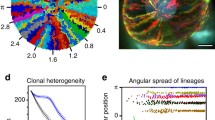Summary
Hemidesmosomes of normal mouse corneal epithelium observed in tangential thin sections, occupy 14% of the basal plasma membrane. They consist of linear chains of densities with an orientation that is not random with respect to the radial axis of the cornea, tending to parallel it. During the repair of a small epithelial defect, cells of the corneal epithelium peripheral to the defect show chains of hemidesmosomes arranged parallel to the direction of migration of the epithelial sheet. This is parallel to the radius, like the orientation of the normal chains. Cells of the area that was denuded of epithelium, and is being resurfaced, show no hemidesmosomes. During repair of a large defect of the corneal epithelium hemidesmosomes are present on the cells covering the denuded area but they are small, few in number compared to the normal, and many are not arranged in chains. These small hemidesmosomes appear to be points of attachment of very fine basal filaments, possibly actin.
Similar content being viewed by others
References
Andersen L (1980) Cell junctions in squamous epithelium during wound healing in palatal mucosa of guinea pigs. Scand J Dent Res 88:328–339
Beerens EGJ, Slot JW, van der Leun JC (1975) Rapid regeneration of the dermal-epidermal junction after partial separation by vacuum: an electron microscopic study. J Invest Dermatol 65:513–521
Blümcke S, Rode J, Niedorf HR (1969) Formation of basement membrane during regeneration of corneal epithelium. Z Zeilforsch 93:84–92
Briggaman RA, Wheeler CE (1975) The epidermal-dermal junction. J Invest Dermatol 65:71–84
Buck RC (1979) Cell migration in repair of mouse corneal epithelium. Invest Ophthalmol Vis Sci 18:767–784
Flickinger CJ (1970) Extracellular specializations associated with hemidesmosomes in the fetal rat urogenital sinus. Anat Rec 168:195–202
Gipson IK, Anderson RA (1977) Actin filaments in normal and migrating corneal epithelial cells. Invest Ophthalmol Vis Sci 16:161–166
Hardy MH, Sweeney PR, Bellows CG (1978) The effects of vitamin A on the epidermis of the fetal mouse in organ culture — an ultrastructural study. J Ultrastruct Res 64:246–260
Kelly DE (1966) Fine structure of desmosomes, hemidesmosomes, and an adepidermal globular layer in developing newt epidermis. J Cell Biol 28:51–72
Kelly DE, Kuda AM (1981) Traversing filaments in desmosomal and hemidesmosomal attachments: freeze-fracture approaches toward their characterization. Anat Rec 199:1–14
Kenyon KR, Fogle JA, Stone DL, Stark WJ (1977) Regeneration of corneal epithelial basement membrane following thermal cauterization. Invest Ophthalmol Vis Sci 16:292–301
Khodadoust AA, Silverstein AM, Kenyon KR, Dowling JE (1968) Adhesion of regenerating corneal epithelium. The role of the basement membrane. Am J Ophthalmol 65:339–348
Krawczyk WS, Wilgram G (1973) Hemidesmosome and desmosome morphogenesis during epidermal wound healing. J Ultrastruct Res 45:93–101
Kuwabara T, Perkins DG, Kogan DG (1976) Sliding of the epithelium in experimental corneal wounds. Invest Ophthalmol 15:4–14
La Tessa AJ, Ross MH (1964) Electron microscope studies of nonpenetrating corneal wounds in the early stages of healing. Exp Eye Res 3:298–303
Mann I (1944) A study of epithelial regeneration in the living eye. Br J Ophthalmol 28:26–40
Pfister RR (1975) The healing of corneal epithelial abrasions in the rabbit: a scanning electron microscope study. Invest Ophthalmol 14:648–661
Ross R, Odland G (1969) Fine structure observations of human skin wounds and fibrogenesis. In: Repair and regeneration. The scientific basis for surgical practice. Dumphy JE, Van Winkle W (eds) McGraw Hill Book Co, New York, pp 101–115
Sciubba JJ (1977) Regeneration of the basal lamina complex during epithelial wound healing. J Periodontal Res 12:204–217
Shienvold FL, Kelly DE (1976) The hemidesmosome: new fine structural features revealed by freeze-fracture techniques. Cell Tiss Res 172:289–307
Srinivasan BD, Worgul BV, Iwamoto T, Eakins KE (1977) The reepithelialization of rabbit cornea following partial and complete epithelial denudation. Exp Eye Res 25:343–351
Weiss P, Ferris W (1954) Electron micrograms of larval amphibian epidermis. Exp Cell Res 6:546–549
Author information
Authors and Affiliations
Additional information
Supported by the Medical Research Council of Canada (MT1011)
Rights and permissions
About this article
Cite this article
Buck, R.C. Hemidesmosomes of normal and regenerating mouse corneal epithelium. Virchows Archiv B Cell Pathol 41, 1–16 (1982). https://doi.org/10.1007/BF02890267
Accepted:
Published:
Issue Date:
DOI: https://doi.org/10.1007/BF02890267




